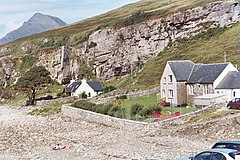Great Estuarine Group
| Great Estuarine Group | |
|---|---|
Ma | |
 Sandstones of the Elgol Sandstone Formation, exposed in the cliff behind Elgol school | |
| Type | Group |
| Unit of | Hebrides Basin |
| Sub-units | |
| Underlies | Staffin Bay Formation or Skye Lava Group |
| Overlies | Bearreraig Sandstone Formation |
| Thickness | circa 33–289 m (108–948 ft) |
| Lithology | |
| Primary | Mudstone |
| Other | Sandstone |
| Location | |
| Region | Scotland |
| Country | |
| Extent | Inner Hebrides |
The Great Estuarine Group is a sequence of Middle Jurassic sedimentary rocks deposited in the
Skye, Raasay, Eigg and Muck.[2] It comprises a series of shales, clays, silts, mudstones, and sandstones deposited in two drainage basins: the Inner Hebrides basin and the Sea of the Hebrides basin.[3] The sediments are equivalent in age to the Inferior and Great Oolite Groups found in southern England
.
The Group overlies the Garantiana Mudstone of the '
Palaeocene.[1]
The lowermost (and hence oldest)
conchostracan fossils. It has also yielded dinosaur
footprints.
At the next stratigraphic level the 'Valtos Sandstone Formation' represents a further series of deltaic sandstones. Large calcareous concretions commonly occur within this formation. They are post-depositional in origin with individual nodules reaching more than a metre in diameter and cutting across the bedding. The 'Duntulm Formation' succeeds the Valtos Formation and is in turn succeeded by the 'Kilmaluag Formation', and then by the youngest unit of the Great Estuarine Group, the 'Skudiburgh Formation'.[4]
